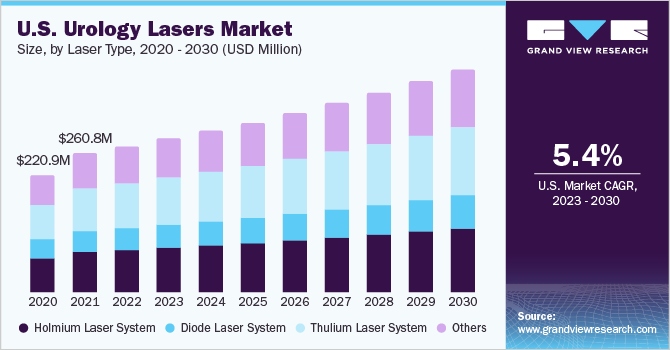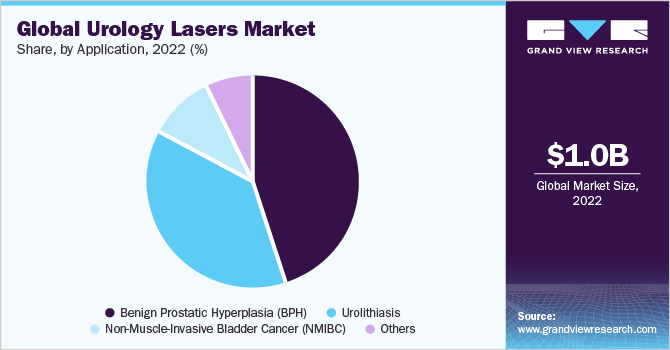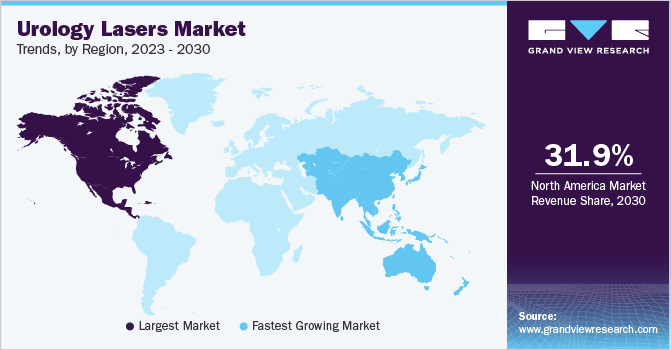- Home
- »
- Medical Devices
- »
-
Urology Lasers Market Size, Share & Trends Report, 2030GVR Report cover
![Urology Lasers Market Size, Share & Trends Report]()
Urology Lasers Market Size, Share & Trends Analysis Report By Laser Type (Holmium Laser System, Diode Laser System, Thulium Laser System), By Application (BPH, Urolithiasis, NMIBC, Others), By Region, And Segment Forecasts, 2023 - 2030
- Report ID: GVR-4-68038-150-4
- Number of Report Pages: 158
- Format: PDF, Horizon Databook
- Historical Range: 2018 - 2021
- Forecast Period: 2023 - 2030
- Industry: Healthcare
Urology Lasers Market Size & Trends
The global urology laser market size was valued at USD 1.04 billion in 2022 and is expected to grow at a compound annual growth rate (CAGR) of 6.0% from 2023 to 2030. The market is primarily driven by factors such as Increase in the number of patients suffering from urology-related disorders and rising preference for minimally invasive surgeries. One of the major factors that drive the market is adoption of minimally invasive surgical technique in holmium systems as well as thulium laser treatment systems. It offers several advantages such as greater effectiveness, safety, and quick recovery minimally invasive technique which has resulted in the increased demand for holmium and thulium systems. These systems have provided successful outcomes while minimizing side effects of treatment, such as shorter hospital stays, quicker recovery, reduction in blood loss, and lower overall body pain as a result of smaller incisions. Thus, its effectiveness and safety characteristics are expected to drive the overall urology lasers market growth.

The market is also significantly impacted by the increase in the cases of diabetes. As per the estimates of the International Diabetes Federation, the prevalence of diabetes is increasing globally, with the highest increases seen in low- and middle-income countries. In 2021, the regions with the highest number of adults living with diabetes were the Western Pacific (167 million), South Asia (88 million), and Europe (59 million). Increasing cases of diabetes lead to increasing cases of urological disorder. Thus, the aforementioned factors are driving the demand for the market.
Technological advancements evolved the scope of laparoscopy in the urology market. The development to treat urological disorders is progressing globally. These laser technologies are usually used to treat benign prostatic hyperplasia and as intracorporeal lithotripters. In addition, the benefits associated with the laser systems, such as less discomfort, enhanced precision, accuracy, and improvement of recovery time, are expected to boost the market. Moreover, increased investment in AI, automation, and robotics is also driving the market demand. For instance, in February 2023, Boston Scientific announced the FDA clearance of LithoVue, a ureteroscope system that aids in monitoring intrarenal pressure. Moreover, the key market players are focusing on technological advancements and developing the new high-end products.
Laser Type Insights
Based on type, the market is segmented into holmium laser system, diode laser system, thulium laser system, and others. The holmium laser system dominated the segment, with the highest revenue share of 30.6% in 2022. The market for holmium systems is growing due to their safety and efficacy in treating patients without a surgical process. Holmium laser is mainly used in prostate surgeries, for which a minimally invasive treatment is preferred for the removal of tissues that blocks urine flow through the prostate. The demand for holmium systems is increasing due to their safety and its effectiveness in the treatment of patients without an incision procedure. The procedure takes about 45-90 minutes depending upon the size of the prostate. This is a less invasive procedure; hence the patients get can get discharged on the same day. These factors are expected to drive the demand for urology lasers.
The thulium laser segment is expected to register the highest CAGR over the forecast period owing to its advantages over Transurethral Resection Prostate (TURP), a traditional method. Thulium laser is considered as the most effective technique for treating BPH as it offers several advantages such as lower rate of bleeding and quick as well as safe procedure requiring fewer incisions. Thulium laser has, therefore, overcome the demerits of TURP technique, which causes significant blood loss, thereby driving the product demand.
Application Insights
Based on application, the market is segmented into Benign Prostatic Hyperplasia (BPH), urolithiasis, Non-Muscle-Invasive Bladder Cancer (NMIBC), and others. The BPH segment accounted for the highest revenue share of 44.56% in 2022. The growth can be attributed to factors such as lack of physical activity, obesity, and a diet high in red meat & fat, which may increase the risk of BPH.
Urolithiasis is expected to be one of the fastest-growing segments over the forecast period owing to an increasing number of patients suffering from stony concretions in urinary tract and bladder. Stony concretions are caused due to factors such as adoption of unhealthy lifestyles and improper sanitation facilities. One of the causes of urolithiasis is high consumption of caffeine intake, which increases urine calcium excretion and causes blood in urine and pain in the abdomen. The development of stones is related to increased excretion of stone forming components such as calcium, urate, xanthine, oxalate, cystine, and phosphate. Thus, the rising number of patients suffering from kidney stones and urinary tract stones and bladder stones are expected to drive the demand for urology lasers for effective treatment.

Benign Prostatic Hyperplasia (BPH) dominated the market based on application owing to its increasing prevalence. It is most prevalent among African males because of the androgen receptor expression, high testosterone levels, and 5-alpha-reductase activity. BPH mainly occurs in two main growth cycles during a man’s life: early puberty and at around 25 years of age. Thus, the increasing prevalence of BPH in men is expected to significantly contribute to the growth of the market.
Regional Insights
North America dominated the market in 2022 with a revenue share of 31.94%. The growth in this region can be attributed to the increasing prevalence of urolithiasis, BPH, and other urology-related disorders. In addition, according to the NCBI, 50% of the U.S. patients have urolithiasis due to calcium and fluid consumption, which plays a significant role in the production of urinary stones. Technological advancements in urology laser equipment play a vital role in driving the demand for urology lasers. For instance, Lumenis, a urology device, offers MOSES technology, which provides technologically advanced holmium laser lithotripsy and Benign Prostatic Hyperplasia (BPH) treatments. Thus, rising technical advancements in the treatment of clinical applications are driving the market growth in the region.

Asia Pacific is expected to register the highest CAGR over the forecast period due to the increasing number of people suffering from urolithiasis and the subsequent rise in lithotripsy procedures in the region. According to the NCBI, 19% of the Asian population suffers from urolithiasis, wherein males are more likely to develop this condition due to the formation of genetic mutations, dietary habits, and various climatic factors. In addition, less fluid intake, as well as climatic factors (hot temperature and high exposure to the sun), increase the risk of developing urolithiasis as well as other urology-related problems. Thus, increasing instances of urology-related conditions drives the growth of the market.
Key Companies & Market Share Insights
The players focus on launching innovative laparoscopic urology devices, researching technological advancements, and implementing growth strategies such as mergers and acquisitions. For instance, Olympus Corporation, in December 2022, acquired Odin Vision. As a result of the acquisition, it could offer novel AI-powered solutions & data-driven insights that alter patient care and enhance clinical & procedural workflows. Some of the prominent players in the global urology laser market include:
-
Olympus Corporation
-
Boston Scientific Corporation
-
Lumenis
-
Cook Medical
-
OmniGuide Holdings, Inc.
-
Allengers Medical Systems Limited
-
CR BARD (BD)
-
Surgical Lasers Inc.
Urology Lasers Market Report Scope
Report Attribute
Details
Market size value in 2023
USD 1.1 billion
Revenue forecast in 2030
USD 1.66 billion
Growth Rate
CAGR of 6.0% from 2023 to 2030
Base year for estimation
2022
Historical data
2018 - 2021
Forecast period
2023 - 2030
Report updated
June 2023
Quantitative units
Revenue in USD million and CAGR from 2023 to 2030
Report coverage
Revenue forecast, company ranking, competitive landscape, growth factors, and trends
Segments covered
Laser type, application, region
Regional scope
North America; Europe; Asia Pacific; Latin America; MEA
Country scope
U.S.; Canada; U.K.; Germany; France; Italy; Spain; Denmark; Swede; Norway; Japan; China; India; Australia; South Korea; Brazil; Mexico; Colombia; Argentina; South Africa; Saudi Arabia; UAE; Kuwait
Key companies profiled
Olympus Corporation; Boston Scientific Corporation; Lumenis; Cook medical; OmniGuide Holdings, Inc.; Allengers Medical Systems Limited; CR BARD (BD); Surgical Lasers Inc.
Customization scope
Free report customization (equivalent up to 8 analysts working days) with purchase. Addition or alteration to country, regional & segment scope.
Pricing and purchase options
Avail customized purchase options to meet your exact research needs. Explore purchase options
Global Urology Lasers Market Report Segmentation
This report forecasts revenue growth and provides an analysis on the latest trends in each of the sub-segments from 2018 to 2030. For the purpose of this study, Grand View Research has segmented the global urology lasers market report on the basis of laser type, application, and region:
-
Laser Type Outlook (Revenue, USD Million, 2018 - 2030)
-
Holmium Laser System
-
Diode Laser System
-
Thulium laser system
-
Others
-
-
Application Outlook (Revenue, USD Million, 2018 - 2030)
-
Benign Prostatic Hyperplasia (BPH)
-
Urolithiasis
-
Non-Muscle-Invasive Bladder Cancer (NMIBC)
-
Others
-
-
Regional Outlook (Revenue, USD Million, 2018 - 2030)
-
North America
-
U.S.
-
Canada
-
-
Europe
-
Germany
-
UK
-
France
-
Italy
-
Spain
-
Denmark
-
Sweden
-
Norway
-
-
Asia Pacific
-
Japan
-
China
-
India
-
Australia
-
South Korea
-
Thailand
-
-
Latin America
-
Mexico
-
Brazil
-
Argentina
-
Colombia
-
-
Middle East and Africa (MEA)
-
South Africa
-
Saudi Arabia
-
UAE
-
Kuwait
-
-
Frequently Asked Questions About This Report
b. The global urology lasers market size was estimated at USD 1.04 billion in 2022 and is expected to reach USD 1.1 billion in 2023.
b. The global urology lasers market is expected to witness a compound annual growth rate of 6.0% from 2023 to 2030 to reach USD 1.66 billion by 2030.
b. North America held the largest share of 31.9% in 2022 due to the increasing prevalence of BPH, urolithiasis, and other urological disorder and the launch of technologically advanced products by the key players in the region.
b. Some key players operating in the urology lasers market include Olympus Corporation, Boston Scientific Corporation, Lumenis, Cook medical, OmniGuide Holdings, Inc., Allengers Medical Systems Limited, and CR BARD (BD), Surgical Lasers Inc
b. Key factors that are driving the growth include increase in the prevalence of urological disorders and rising demand for minimally invasive surgical procedures over the forecast period.
Share this report with your colleague or friend.
![gvr icn]()
NEED A CUSTOM REPORT?
We can customize every report - free of charge - including purchasing stand-alone sections or country-level reports, as well as offer affordable discounts for start-ups & universities. Contact us now
![Certified Icon]()
We are GDPR and CCPA compliant! Your transaction & personal information is safe and secure. For more details, please read our privacy policy.
We are committed towards customer satisfaction, and quality service.
"The quality of research they have done for us has been excellent."





